Geovisualization: A Practical Approach for COVID-19 Spatial Analysis
Abstract
:1. Introduction
2. Literature Review
2.1. Geovisualization of COVID-19 in the International Literature
2.2. Leading Journals and Science Areas in the International Literature
2.3. Co-Citation Analysis of the International Literature
2.4. International WebGIS Applications
2.5. Geovisualization and WebGIS Applications on COVID-19 in the Brazilian Literature
2.6. Literature Summary
3. Materials and Methods
3.1. Study Area
3.2. Data Collection
- Domicile: complete address (city, state, street, number, and neighborhood).
- Patient: age group, sex, and age.
- General: notification date, symptoms (e.g., fever), and epidemiological week. (Epidemiological weeks is a standardized counting system of weeks to compare annual data. By international convention, the first week of the year contains the largest number of days in January, and the last week contains the largest number of days in December [68].)
- Health: Severe Acute Respiratory Infection (SARI), comorbidity, Polymerase Chain Reaction (PCR) or rapid tests, and suspected cases.
3.3. Description of Development Stages
4. Results and Analysis
- https://geotecnologias.com.br/dashboard2.html (accessed on 19 November 2023)
- https://www.youtube.com/watch?v=UpV41QB9YZI (accessed on 19 November 2023)
Policy Highlights
5. Conclusions
Author Contributions
Funding
Data Availability Statement
Conflicts of Interest
References
- Lan, Y.; Desjardins, M.R.; Hohl, A.; Delmelle, E. Geovisualization of COVID-19: State of the Art and Opportunities. Cartogr. Int. J. Geogr. Inf. Geovis. 2021, 56, 2–13. [Google Scholar] [CrossRef]
- Ahasan, R.; Alam, M.S.; Chakraborty, T.; Hossain, M.M. Applications of GIS and geospatial analyses in COVID-19 research: A systematic review. F1000Research 2020, 9, 1379. [Google Scholar] [CrossRef] [PubMed]
- Lan, Y.; Delmelle, E. A web-based analytical framework for the detection and visualization space-time clusters of COVID-19. Cartogr. Geogr. Inf. Sci. 2023, 1–19. [Google Scholar] [CrossRef]
- Supriatna, F.Z.; Ardiansyah, N.R.; Semedi, S.J.M.; Rahatiningtyas, T.N.S. Communicating the High Susceptible Zone of COVID-19 and its Exposure to Population Number through a Web-GIS Dashboard for Indonesia Cases. Int. J. Technol. 2022, 13, 706–716. [Google Scholar] [CrossRef]
- Bandeira, E.D.; Lucena, S.V.; Navoni, J.A.; de Souza, J.R.; Tavares, J.L. Análise Espacial das Taxas de Incidência e Mortalidade da COVID-19 e os Impactos do Saneamento no Munícipio de Natal-RN. In Proceedings of the XIX Congresso Nacional de Meio Ambiente, Poços de Caldas, Brazil, 21–22 September 2022. [Google Scholar]
- Konicek, J.; Netek, R.; Burian, T.; Novakova, T.; Kaplan, J. Non-spatial data towards spatially located news about COVID-19: A semi-automated aggregator of pandemic data from (social) media within the Olomouc Region, Czechia. Data 2020, 5, 76. [Google Scholar] [CrossRef]
- Minghini, M.; Sarretta, A.; Napolitano, M. Openstreetmap contribution to local data ecosystems in COVID-19 times: Experiences and reflections from the Italian case. Data 2022, 7, 39. [Google Scholar] [CrossRef]
- Magalhães SS, A.; Machado, C.J. Conceitos Epidemiológicos e as Pandemias Recentes: Novos Desafios. Cad. Saúde Colet. 2014, 22, 109–110. [Google Scholar] [CrossRef]
- Silva, F.S.; Libório, M.P.; Haddad, P.B. Relação geográfica entre índice de vulnerabilidade social e a transmissão da dengue: Estudo de caso de Praia Grande, São Paulo. Rev. Espinhaço 2018, 7, 39–48. [Google Scholar]
- Van Eck, N.; Waltman, L. Software survey: VOSviewer, a computer program for bibliometric mapping. Scientometrics 2010, 84, 523–538. [Google Scholar] [CrossRef]
- Libório, M.P.; Martins CA, P.; Laudares, S.; Ekel, P.I. Method of preparing an international and national literature review for novice researchers. MethodsX 2023, 10, 102165. [Google Scholar] [CrossRef]
- Zhou, M.; Fu, Q.; Li, Y.; Wang, Y.; Wang, X.; Hu, W. Discovering spatiotemporal flow patterns: Where the origin–destination map meets empirical orthogonal function decomposition. Cartogr. Geogr. Inf. Sci. 2023, 50, 113–129. [Google Scholar] [CrossRef]
- Odunsi, O.M.; Salisu, U.O.; Taiwo, A.O.; Odufuwa, B.O.; Badiora, A.I.; Onanuga, M.Y.; Fasina, O.S.; Dada, O.T.; Ogunseye, N.O.; Momodu, S.O.; et al. Geo-Visualisation of COVID-19 Pandemic and Vaccination in Nigeria: A Regional Approach. J. Geovis. Spat. Anal. 2023, 7, 29. [Google Scholar] [CrossRef]
- Small, H. Co-citation in the scientific literature: A new measure of the relationship between two documents. J. Am. Soc. Inf. Sci. 1973, 24, 265–269. [Google Scholar] [CrossRef]
- Jung, J.K.; Elwood, S. Extending the qualitative capabilities of GIS: Computer-aided qualitative GIS. Trans. GIS 2010, 14, 63–87. [Google Scholar] [CrossRef]
- Fotheringham, A.S. A new set of spatial-interaction models: The theory of competing destinations. Environ. Plan. A Econ. Space 1983, 15, 15–36. [Google Scholar] [CrossRef]
- Li, T.; Corcoran, J.; Pullar, D.; Robson, A.; Stimson, R. A geographically weighted regression method to spatially disaggregate regional employment forecasts for South East Queensland. Appl. Spat. Anal. Policy 2009, 2, 147–175. [Google Scholar] [CrossRef]
- Kim, D. Visualizing the regional patterns of two crises: The COVID-19 outbreak and decreasing MSME sales during three different phases of 2020 in Korea. Environ. Plan. A Econ. Space 2021, 53, 1591–1593. [Google Scholar] [CrossRef]
- Iyanda, A.E.; Adeleke, R.; Lu, Y.; Osayomi, T.; Adaralegbe, A.; Lasode, M.; Chima-Adaralegbe, N.J.; Osundina, A.M. A retrospective cross-national examination of COVID-19 outbreak in 175 countries: A multiscale geographically weighted regression analysis (January 11–June 28, 2020). J. Infect. Public Health 2020, 13, 1438–1445. [Google Scholar] [CrossRef]
- Pászto, V.; Burian, J.; Macku, K. COVID-19 data sources: Evaluation of map applications and analysis of behavior changes in europe’s population. Geografie 2020, 125, 171–209. [Google Scholar] [CrossRef]
- Zhai, W.; Liu, M.; Peng, Z.R. Social distancing and inequality in the United States amid COVID-19 outbreak. Environ. Plan. A Econ. Space 2021, 53, 3–5. [Google Scholar] [CrossRef]
- Gavurova, B.; Kelemen, M.; Polishchuk, V. Expert model of risk assessment for the selected components of smart city concept: From safe time to pandemics as COVID-19. Socioecon. Plan. Sci. 2022, 82, 101253. [Google Scholar] [CrossRef]
- Zhou, J.; Wu, J.; Ma, H. Abrupt changes, institutional reactions, and adaptive behaviors: An exploratory study of COVID-19 and related events’ impacts on Hong Kong’s metro riders. Appl. Geogr. 2021, 134, 102504. [Google Scholar] [CrossRef] [PubMed]
- Balla, D.; Zichar, M.; Kiss, E.; Szabó, G.; Mester, T. Possibilities for Assessment and Geovisualization of Spatial and Temporal Water Quality Data Using a WebGIS Application. ISPRS Int. J. Geo-Inf. 2022, 11, 108. [Google Scholar] [CrossRef]
- Ponjavic, M.; Karabegovic, A.; Ferhatbegovic, E.; Tahirovic, E.; Uzunovic, S.; Travar, M.; Pilav, A.; Mulić, M.; Karakaš, S.; Avdić, N.; et al. Spatio-temporal data visualization for monitoring of control measures in the prevention of the spread of COVID-19 in Bosnia and Herzegovina. Med. Glas. 2020, 17, 265–274. [Google Scholar]
- Pasquaré Mariotto, F.; Antoniou, V.; Drymoni, K.; Bonali, F.L.; Nomikou, P.; Fallati, L.; Karatzaferis, O.; Vlasopoulos, O. Virtual geosite communication through a webgis platform: A case study from santorini island (Greece). Appl. Sci. 2021, 11, 5466. [Google Scholar] [CrossRef]
- Pasquaré Mariotto, F.; Corti, N.; Drymoni, K. Advanced Technologies for Geosite Visualization and Valorization: A Review. Appl. Sci. 2023, 13, 5598. [Google Scholar] [CrossRef]
- Martínez-Hernández, C.; Piskorski, R.; Stoffelen, A. Designing online workshops for teacher trainees: Heritage mapping with Web GIS Story Maps. Eur. J. Geogr. 2023, 14, 68–78. [Google Scholar] [CrossRef]
- Beuren, A.T.; de Freitas, H.J.T.; Naves, T.F.; Flórez, H.A.R.; Sepúlveda, G.P.L.; da Silva Soares, A.; de Lima Soares, T.W. Plataforma de Monitoramento Inteligente da COVID-19. Res. Soc. Dev. 2022, 11, e580111436659. [Google Scholar] [CrossRef]
- Marques da Costa, N.; Mileu, N.; Alves, A. Dashboard comprime_compri_mov: Multiscalar spatio-temporal monitoring of the COVID-19 pandemic in Portugal. Future Internet 2021, 13, 45. [Google Scholar] [CrossRef]
- Li, J.; Wang, X.; He, Z.; Zhang, T. A personalized activity-based spatiotemporal risk mapping approach to the COVID-19 pandemic. Cartogr. Geogr. Inf. Sci. 2021, 48, 275–291. [Google Scholar] [CrossRef]
- Steger, A.; Evans, E.; Wee, B. Emotional cartography as a window into children’s well-being: Visualizing the felt geographies of place. Emot. Space Soc. 2021, 39, 100772. [Google Scholar] [CrossRef]
- Pala, D.; Parimbelli, E.; Larizza, C.; Cheng, C.; Ottaviano, M.; Pogliaghi, A.; Đukić, G.; Jovanović, A.; Milićević, M.; Urošević, V.; et al. A new interactive tool to visualize and analyze COVID-19 data: The periscope atlas. Int. J. Environ. Res. Public Health 2022, 19, 9136. [Google Scholar] [CrossRef] [PubMed]
- Torres-Ruiz, M.; Quintero, R.; Guzman, G.; Chui, K.T. Healthcare Recommender System Based on Medical Specialties, Patient Profiles, and Geospatial Information. Sustainability 2022, 15, 499. [Google Scholar] [CrossRef]
- Liu, F.; Nie, X.; Wu, A.; Zhao, Z.; Ma, C.; Ning, L.; Zhu, Y.; Wang, L.; Guo, X.; Li, X. Data assimilation method for improving the global spatiotemporal predictions of epidemic dynamics yielded by an ensemble Kalman filter and Metropolis–Hastings sampling. Nonlinear Dyn. 2023, 111, 15573–15589. [Google Scholar] [CrossRef]
- Meddah, F.; Guerroudji, W.H. A chorem-based approach to visualizing COVID-19-related data. Cartogr. Geogr. Inf. Sci. 2023, 1–14. [Google Scholar] [CrossRef]
- Chen, M.; Yan, Y.; Feng, C.C.; Chen, S.; Wang, J.; Ye, M. Understanding the mobility patterns of Mass Rapid Transit (MRT) passengers amid COVID-19 in Singapore using smart card data. Singap. J. Trop. Geogr. 2023, 44, 414–437. [Google Scholar] [CrossRef]
- Rezk, A.A.; Hendawy, M. Informative cartographic communication: A framework to evaluate the effects of map types on users’ interpretation of COVID-19 geovisualizations. Cartogr. Geogr. Inf. Sci. 2023, 1–18. [Google Scholar] [CrossRef]
- Li, R. Visualizing COVID-19 information for public: Designs, effectiveness, and preference of thematic maps. Hum. Behav. Emerg. Technol. 2021, 3, 97–106. [Google Scholar] [CrossRef]
- Schmidt, F.; Dröge-Rothaar, A.; Rienow, A. Development of a Web GIS for small-scale detection and analysis of COVID-19 (SARS-CoV-2) cases based on volunteered geographic information for the city of Cologne, Germany, in July/August 2020. Int. J. Health Geogr. 2021, 20, 40. [Google Scholar] [CrossRef]
- Tiwari, A.; Aljoufie, M. A qualitative geographical information system interpretation of mobility and COVID-19 pandemic intersection in Uttar Pradesh, India. Geospat. Health 2021, 16, 124–136. [Google Scholar] [CrossRef]
- Sadoun, B.; Al-Bayari, O.; Al-Tawara, S. Open Source GIS Solution: An Overview of the Architecture of Free Open Source Web GIS. Jordan J. Earth Environ. Sci. 2022, 13, 74–81. [Google Scholar]
- Phang, P.; Yap, M.Y.; Zakaria, S.; Labadin, J. Geo-visualization of Sarawak COVID-19 Publicly Available Data Employing Open-source Geospatial Software. Univers. J. Public Health 2023, 11, 34–49. [Google Scholar] [CrossRef]
- Heintzman, R. Interactive Geovisualizations (iGEO): A new approach to teaching and learning physical geography. Rev. Int. Geogr. Educ. Online 2020, 10, 664–683. [Google Scholar] [CrossRef]
- Heintzman, R.; Brandi, A.; Kelley, M.; Marvin, M.C. A Physical Geography Lab’s Online Transition: Student and Instructor Insights Using iGEO Video Games during the Pandemic. J. Geogr. 2023, 122, 1–9. [Google Scholar] [CrossRef]
- Geraghty, E.; Kerski, J. The impact of COVID-19 on geography, GIS, and education. J-READING J. Res. Didat. Geogr. 2020, 2, 53–66. [Google Scholar]
- Casquero-Modrego, N.; Núñez-Andrés, M.A.; Iniesto-Alba, M.J. Effects of small-group learning on the assessment of professional skills through a PBL activity. Trans. GIS 2022, 26, 1735–1753. [Google Scholar] [CrossRef]
- Elalami, M.E.; Elshafei, I.A.; Abdelkader, H.E. Location-Based Services Using Web-Gis by An Android Platform to Improve Students’ Navigation During COVID-19. J. Theor. Appl. Inf. Technol. 2022, 100, 3441–3456. [Google Scholar]
- Kafarski, K.; Kazak, J.K. Erasmus Staff mobility in the building of a European network: The case of a Central European university. Sustainability 2022, 14, 4949. [Google Scholar] [CrossRef]
- Puertas-Aguilar, M.Á.; Álvarez-Otero, J.; de Lázaro-Torres, M.L. The challenge of teacher training in the 2030 agenda framework using geotechnologies. Educ. Sci. 2021, 11, 381. [Google Scholar] [CrossRef]
- Martínez-Hernández, C.; Stoffelen, A.; Piskorski, R. Obtaining geographical competences through online cartography of familiar and unfamiliar urban heritage: Lessons from student workshops. J. Geogr. High. Educ. 2022, 1–20. [Google Scholar] [CrossRef]
- Gaie, C. Providing detailed information on national policies to cope with the COVID-19 pandemic. Digit. Gov. Res. Pract. 2020, 2, 1–11. [Google Scholar] [CrossRef]
- Fassoulas, C.; Nikolakakis, E.; Staridas, S. Digital tools to serve geotourism and sustainable development at Psiloritis UNESCO Global Geopark in COVID times and beyond. Geosciences 2022, 12, 78. [Google Scholar] [CrossRef]
- MacTavish, M.; Wecker, L.; Samavati, F. Perspective Charts in a Multi-Foci Globe-Based Visualization of COVID-19 Data. ISPRS Int. J. Geo-Inf. 2022, 11, 223. [Google Scholar] [CrossRef]
- Medeiros, E.; Valente, B. Assessing impacts of public policies towards environmental sustainability in an EU region: North of Portugal. Eur. Plan. Stud. 2023, 1–20. [Google Scholar] [CrossRef]
- Mesquita, A.L.; de Souza, M.B.; Cardoso, P.M.; Braga, T.G.M.; Paiva, P.F.P.R. Gestão de Resíduos Sólidos durante a pandemia da COVID-19 no município de Belém (PA). Rev. Bras. Educ. Ambient. RevBEA 2022, 17, 150–165. [Google Scholar] [CrossRef]
- Santos Costa, S.S.; do Nascimento, M.A.L.; da Silva, M.L.N. Roteiro virtual pelos Geossítios do Geoparque Aspirante Seridó: Ferramentas cartográficas livres do Google® para Geoeducação. Terrae Didat. 2022, 18, e022004. [Google Scholar] [CrossRef]
- Leão AL, F.; Dalgallo, A.Z.; Kanashiro, M. Mudanças no comportamento de caminhada durante a pandemia de COVID-19 no Brasil. In Proceedings of the XIX Encontro Nacional de Tecnologia do Ambiente Construído, Canela, Brasil, 9–11 November 2022; Volume 19, pp. 1–10. [Google Scholar]
- Freitas Pereira, A.C.; Cândido, R.G. Ensino Virtual de Cartografia Digital Diante da Pandemia COVID-19. In Diálogos Sobre a Docência Universitária: Desafios e Superações do Grupo de Estudos de Práticas em Ensino (GEPE) Sobre A; Torres, A.C.P.L.G.C., Faquin, E.S., Moura, J.D.P.M., Eds.; Pedro & João Editors; Docência Universitária: São Carlos, Brasil, 2022; 274p. [Google Scholar]
- Machado, B.H.F.; da Silva, P.M.; da Silva, T.M.; da Silva Leal, S.P.; Vargas, K.B.; de Sousa, G.M. Geopasseios virtuais como alternativa de imersão no campus da UFRRJ e FLONA Mário Xavier durante a pandemia. Rev. Bras. Extensão Univ. 2022, 13, 291–301. [Google Scholar] [CrossRef]
- Antero, R.; Lima, M.P.; da Silva Ferreira, N.; de Souza, J.V.S.A.; Barbosa, L.S. Geotecnologias como recurso didático nas aulas remotas de geografia: Experiências do pibid na semana do meio ambiente. DESAFIOS-Rev. Interdiscip. Univ. Fed. Tocantins 2023, 125–139. [Google Scholar] [CrossRef]
- Dantas, S.; Mesquita, D.; Silva, J. Alfabetização cartográfica no Ensino Fundamental:: A retomada do processo pós ensino remoto emergencial. Metodol. Aprendizado 2023, 6, 247–255. [Google Scholar] [CrossRef]
- Habowski, J.; Sccoti, A.; Siqueira, J. Relatos e experiências: Oficina remota de introdução ao software Qgis na XII Semana Acadêmica de geografia da Universidade Federal de Santa Maria. Metodol. Aprendizado 2023, 6, 165–174. [Google Scholar] [CrossRef]
- Palhares, R.H.; Hermano, V.M. Geotecnologias aplicadas no mapeamento da COVID-19: Uma abordagem metodológica em Belo Horizonte-MG. GEOgraphia 2023, 25, 1–17. [Google Scholar]
- IBGE—Instituto Brasileiro de Geografia e Estatística. Cidades e Estados. 2023. Available online: https://www.ibge.gov.br/cidades-e-estados (accessed on 23 January 2023).
- IBGE—Instituto Brasileiro de Geografia e Estatística. Censo Demográfico. Censo. 2010. Available online: https://censo2010.ibge.gov.br/ (accessed on 23 January 2023).
- Barros, A.J.; Monteiro Romão, E.; Laudares, S.; Aldighieri Moraes, R.; Guimarães Gomes, G. The interdisciplinarity of geography and geoprocessing in the mapping of COVID 19 cases in the municipality of João Monlevade-Minas Gerais. Res. Soc. Dev. 2020, 9, e8309109173. [Google Scholar] [CrossRef]
- Bastos, L.S.; Niquini, R.P.; Lana, R.M.; Villela, D.A.; Cruz, O.G.; Coelho, F.C.; Codeço, C.T.; Gomes, M.F. COVID-19 and hospitalizations for SARI in Brazil: A comparison up to the 12th epidemiological week of 2020. Cad. Saude Publica 2020, 36, e00070120. [Google Scholar] [CrossRef] [PubMed]
- Libório, M.P.; Martinuci, O.D.S.; Bernardes, P.; Krohling, N.C.A.C.C.; Castro, G.; Guerra, H.L.; Ribeiro, E.A.; Fonzar, U.J.V.; Francisco, Í.D.C. Social vulnerability and COVID-19 in Maringá, Brazil. Spat. Inf. Res. 2023, 31, 51–59. [Google Scholar] [CrossRef]
- Libório, M.P.; Ekel, P.Y.; de Abreu, J.F.; Laudares, S. Factors that most expose countries to COVID-19: A composite indicators-based approach. GeoJournal 2022, 87, 5435–5449. [Google Scholar] [CrossRef] [PubMed]
- Fochezatto, A.; Sanguinet, E.R.; Batistela, P.; Valdes, R. Income Leakage Regional Effects: Supply and Demand Shocks during the Pandemic in Brazil and Chile. Geographies 2023, 3, 654–672. [Google Scholar] [CrossRef]
- Owuor, I.; Hochmair, H.H. Temporal Relationship between Daily Reports of COVID-19 Infections and Related GDELT and Tweet Mentions. Geographies 2023, 3, 584–609. [Google Scholar] [CrossRef]
- Wang, K.; Zhao, X. The Impact of COVID-19 Lockdowns on Satellite-Observed Aerosol Optical Thickness over the Surrounding Coastal Oceanic Areas of Megacities in the Coastal Zone. Geographies 2021, 1, 381–397. [Google Scholar] [CrossRef]
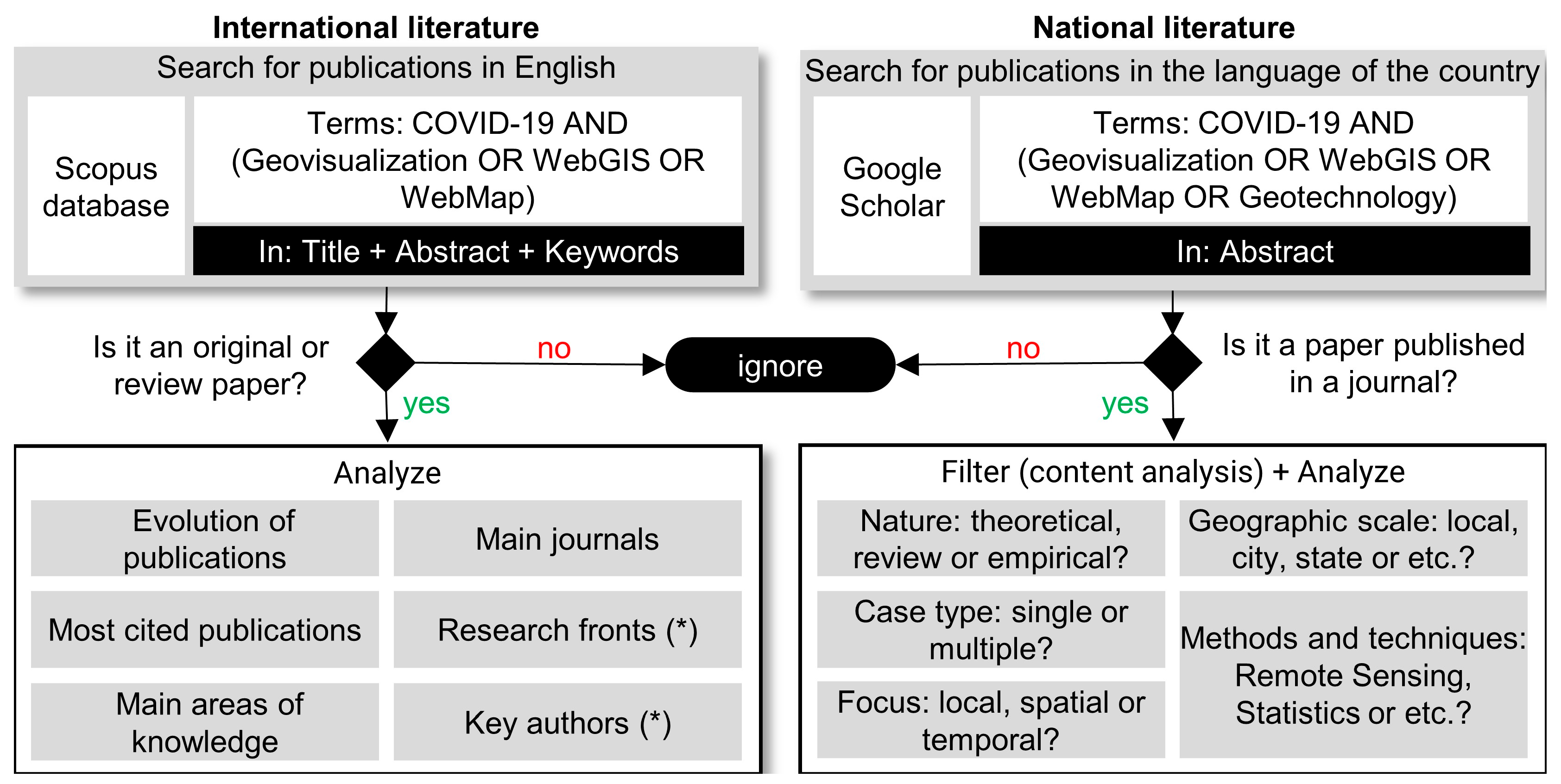
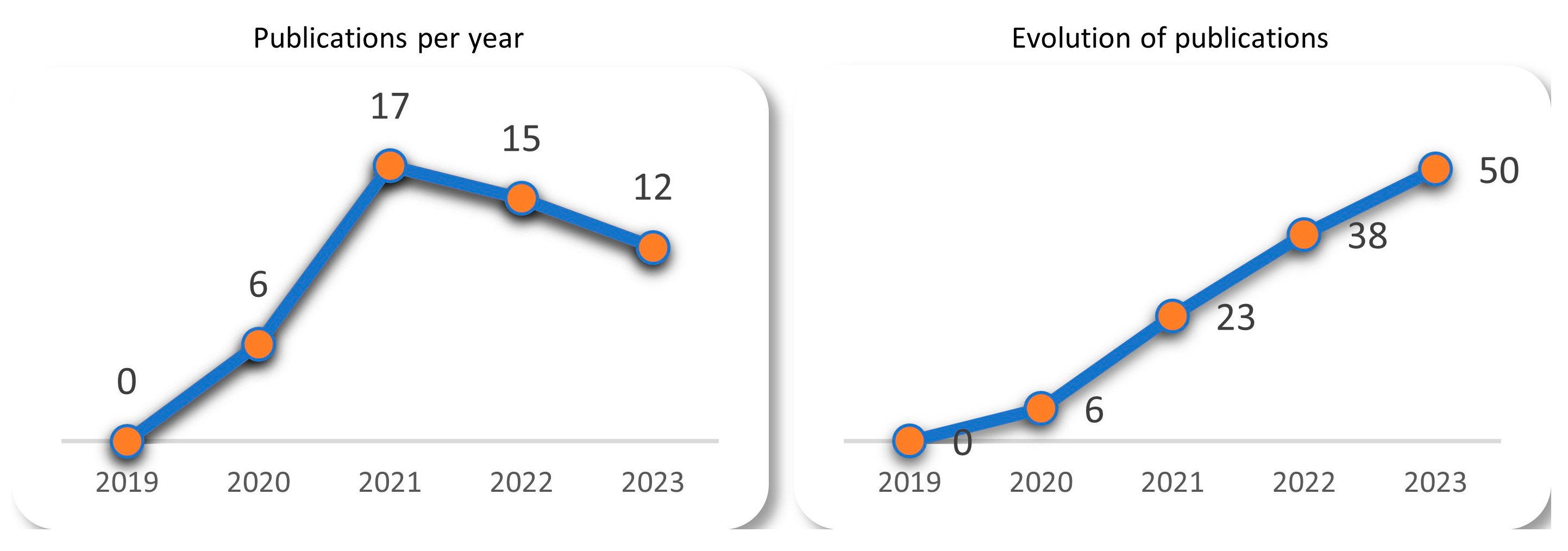
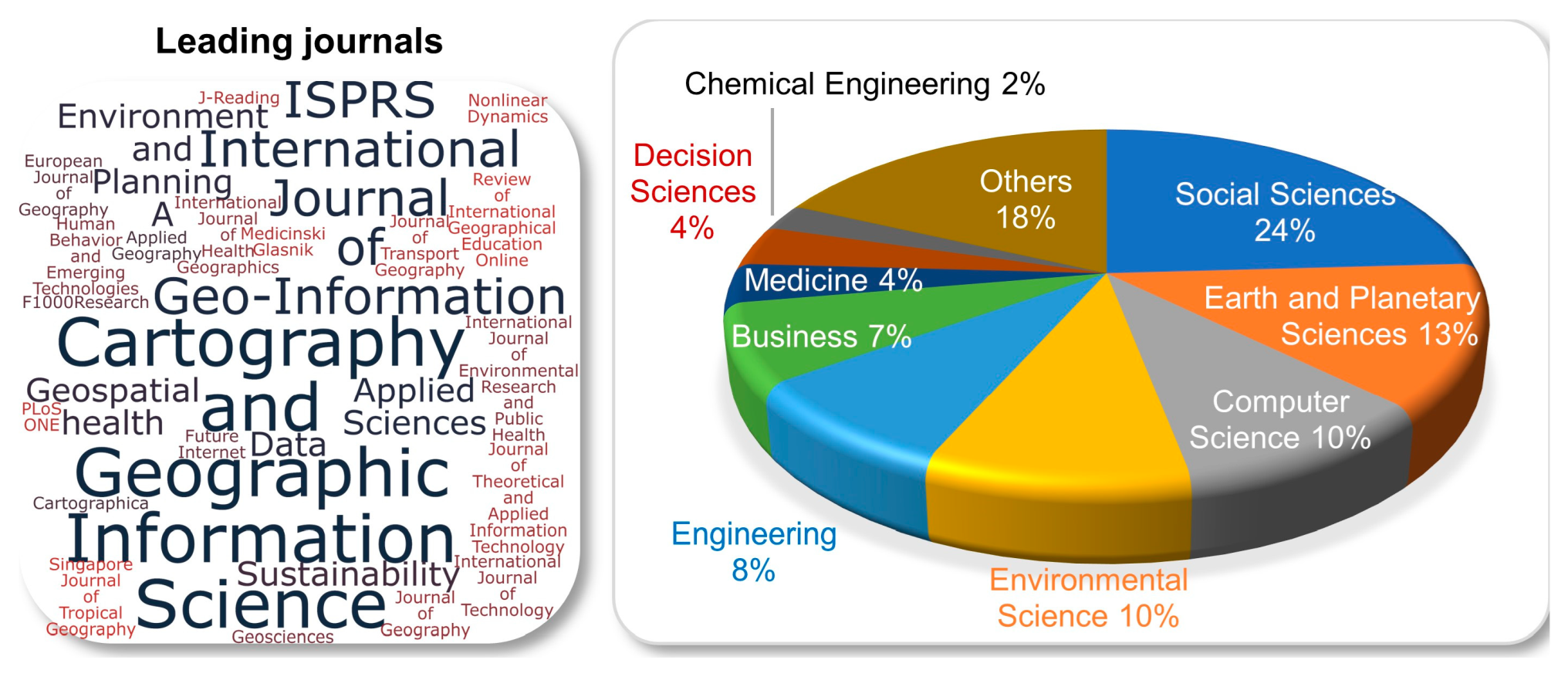
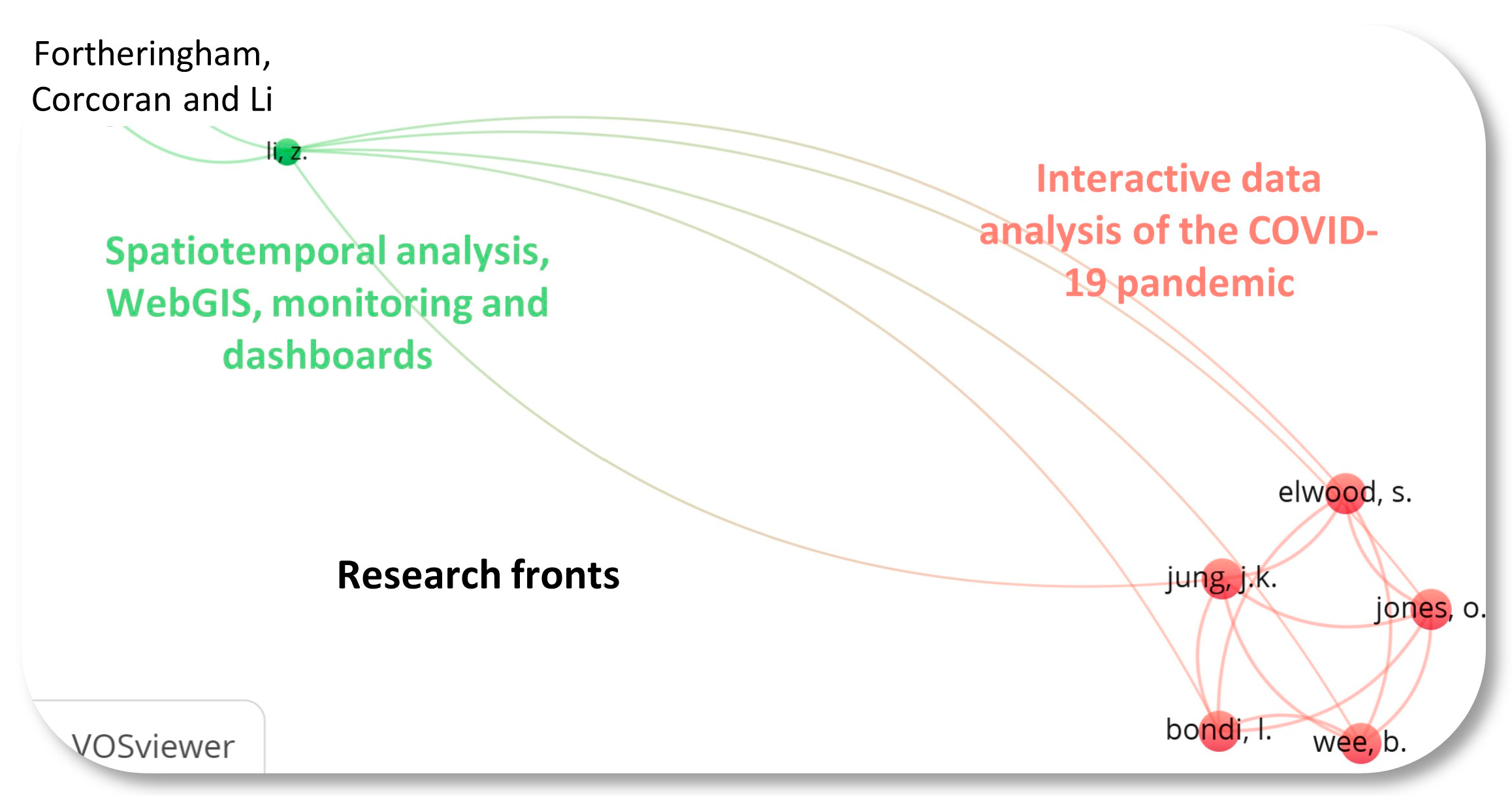
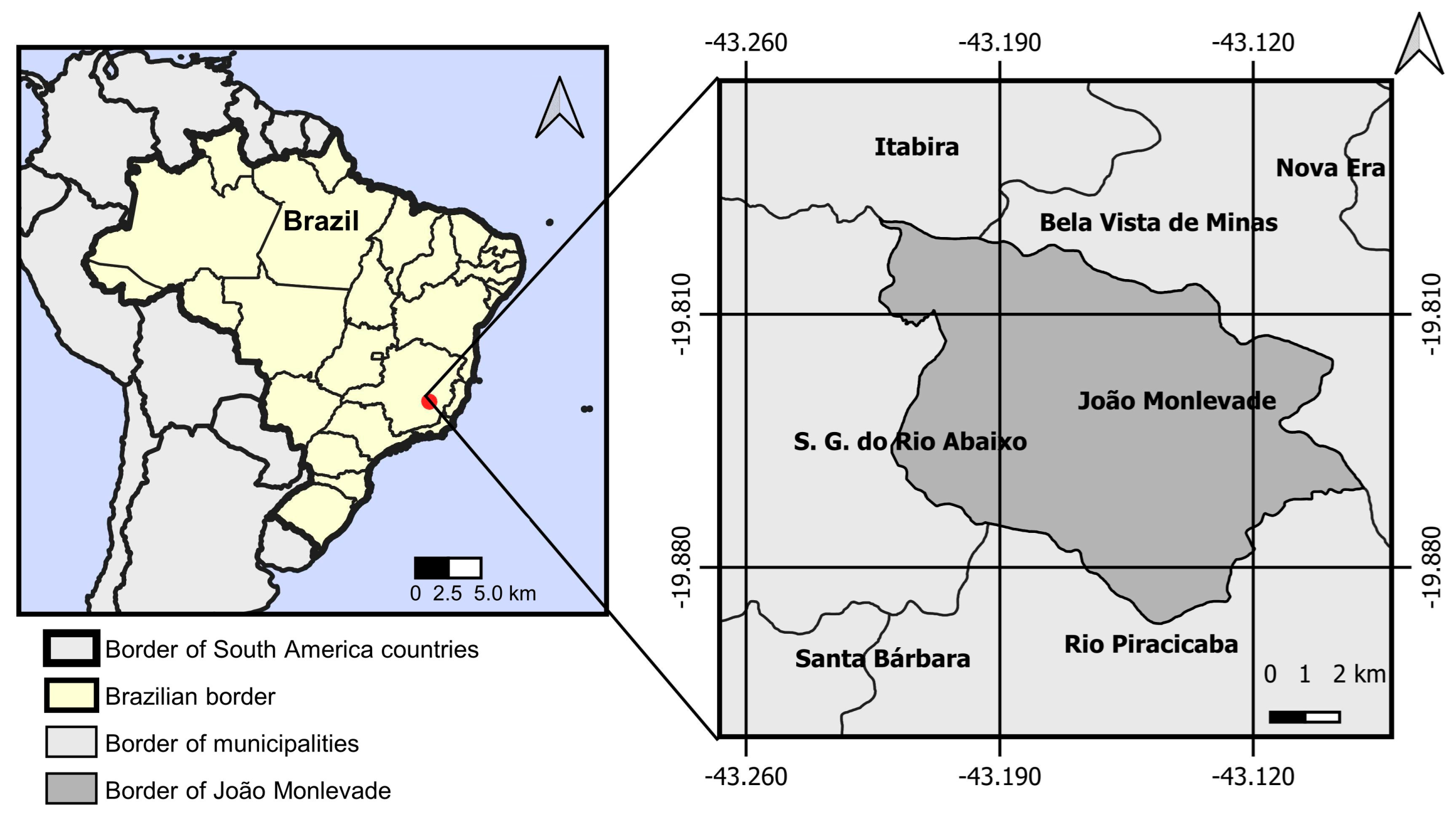

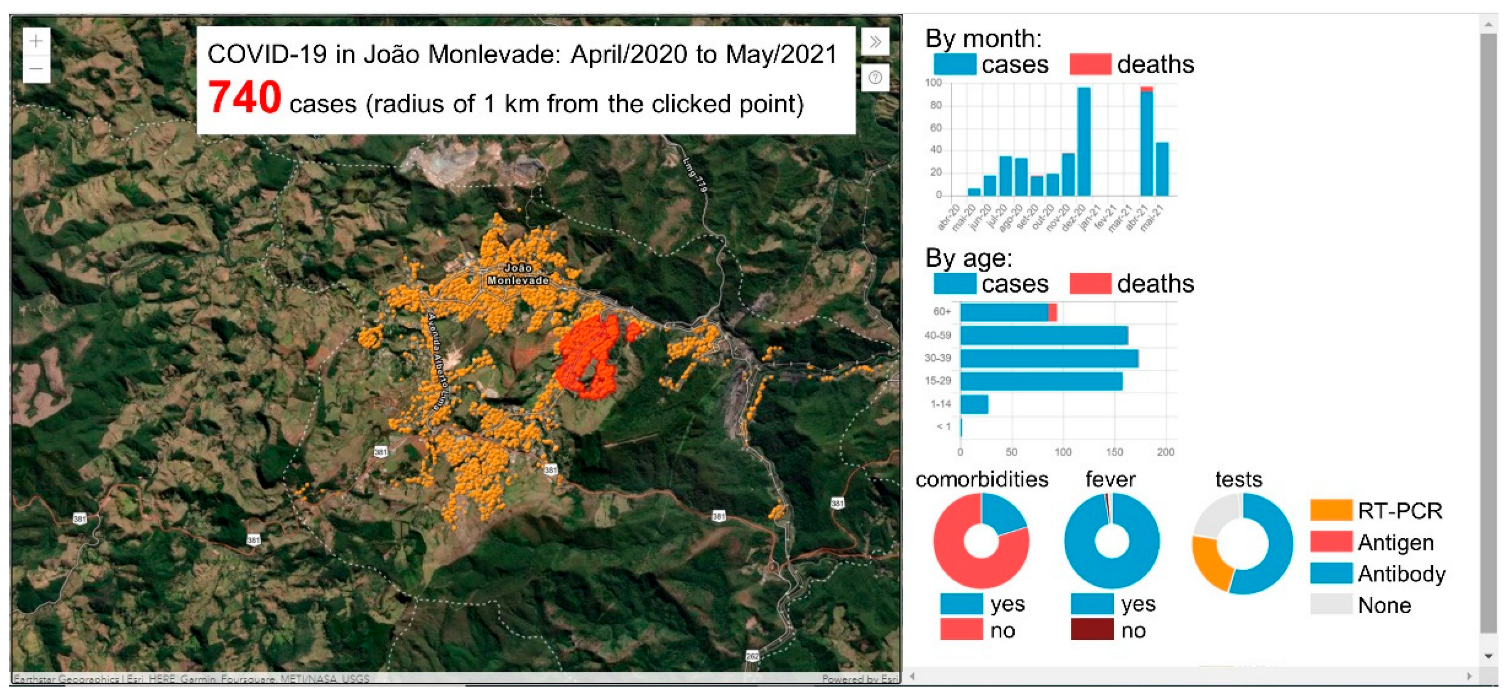
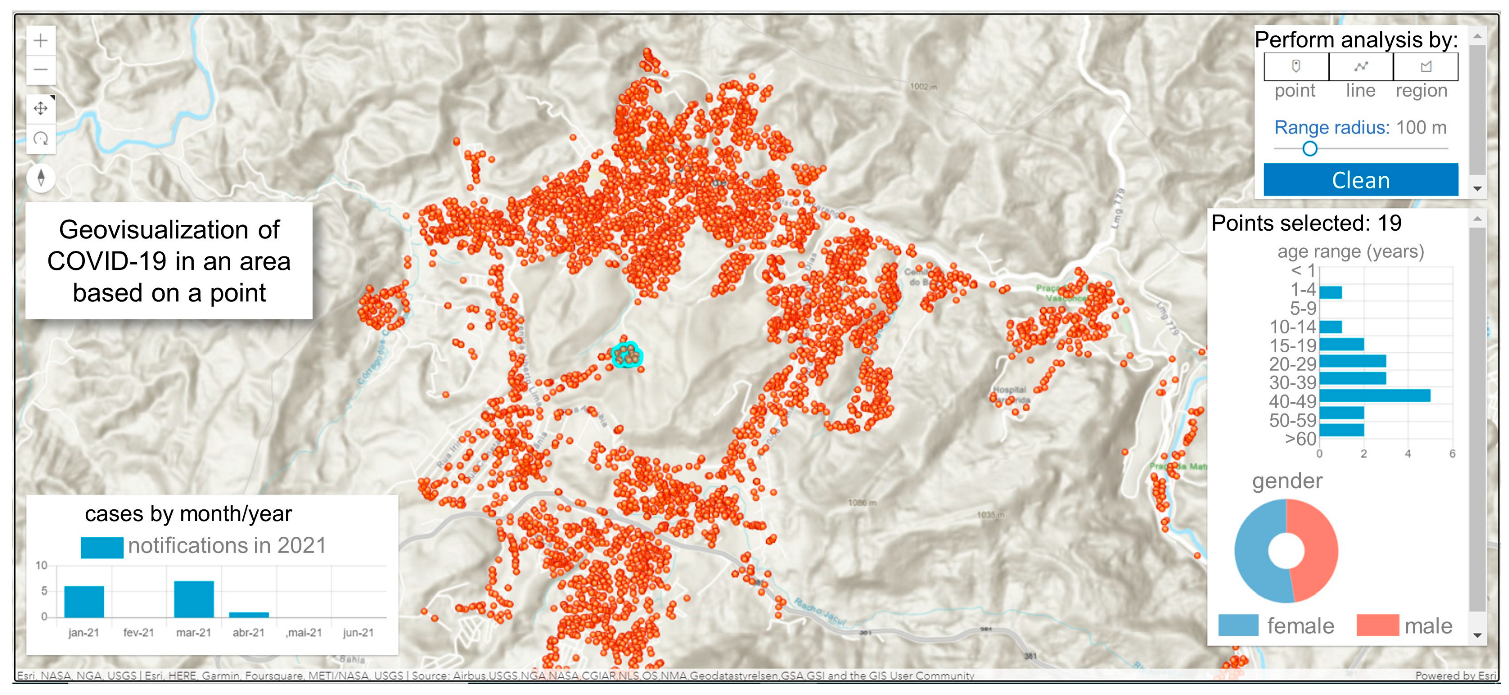
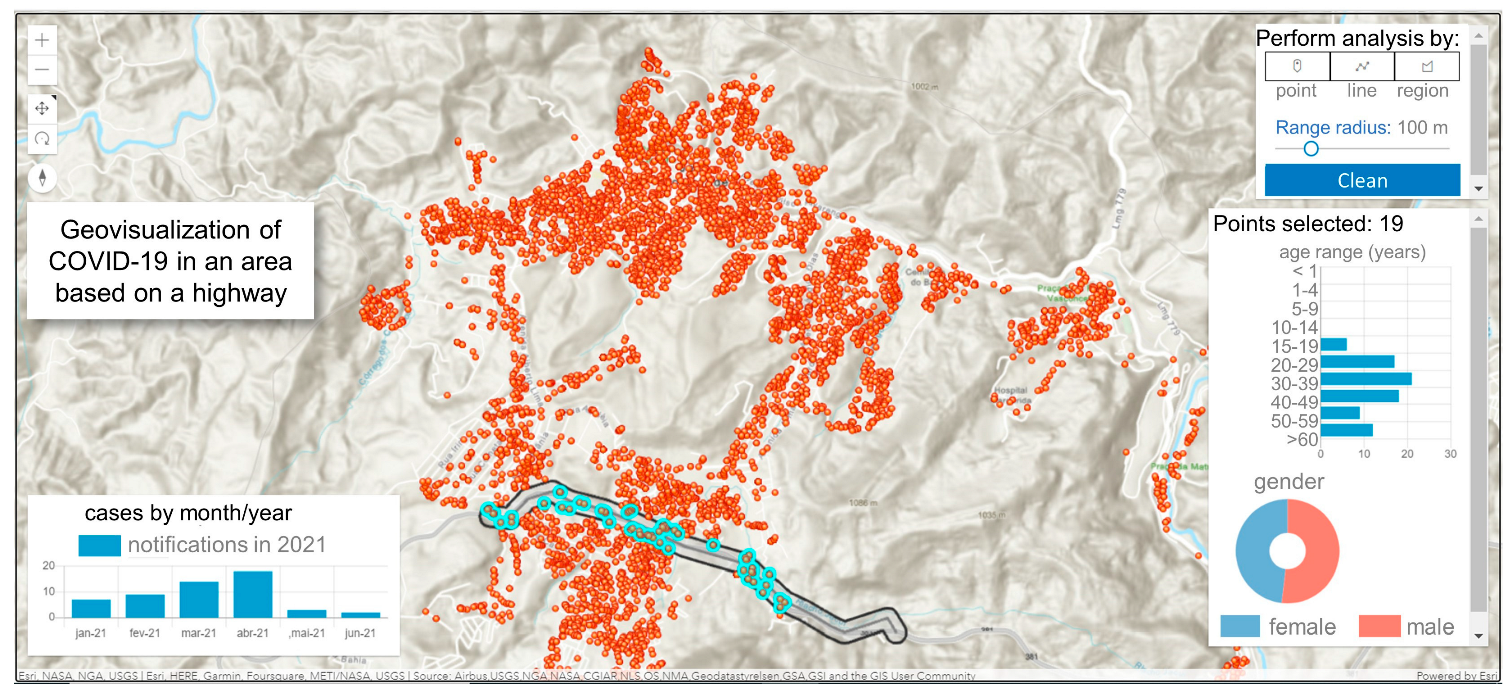

| Region | Number |
|---|---|
| Europe | 33 |
| Asia | 17 |
| North America 1 | 17 |
| Africa | 5 |
| Latin America | 2 |
| WebGIS Associated with | Papers | References |
|---|---|---|
| Other data (e.g., tourism and education) | 21 | Balla et al. [24], Pasquaré et al. [26,27], Heintzman [44], Geraghty and Kerski [46], Casquero-Modrego et al. [47], Elalami et al. [48], Kafarski and Kazak [49], Heintzman et al. [45], Martínez- Hernández et al. [28], Puertas-Aguilar et al. [50], Martínez- Hernández et al. [51], Gaie [52], Fassoulas et al. [53], Mesquita et al. [56], Santos Costa et al. [57], Leão et al. [58], Freitas Pereira et al. [59], Machado et al., [60], Antero et al. [61], Dantas et al. [62], and Habowski et al. [63]. |
| Only COVID-19 data | 11 | Beuren et al. [29], Marques da Costa et al. [30], Meddah and Guerroudji [36], Li [39], Schmidt et al. [40], Tiwari and Aljoufie [41], Supriatna et al. [4], Sadoun et al. [42], Phang et al. al. [43], MacTavish et al. [54], and Bandeira et al. [5]. |
| Health, social, and demographic data | 9 | Kim [18], Iyanda et al. [19], Zhai et al. [21], Gavurova et al. [22], Li et al. [31], Steger [32], Pala et al. [33], Palhares and Hermano [64], and Lan and Delmelle [3]. |
| Mobility, satellite, and social media data | 8 | Pászto et al. [20], Zhai et al. [21], Zhou et al. [23], Ponjavic et al. [25], Chen et al. [37], Zhou et al. [12], Konicek et al. [6], and Minghini et al. [7]. |
| Health system data | 3 | Liu et al. [35], Odunsi et al. [14], and Torres-Ruiz et al. [34]. |
| Non-spatial analysis | 3 | Ahasan et al. [2], Lan et al. [1], and Rezk and Hendawy [38]. |
Disclaimer/Publisher’s Note: The statements, opinions and data contained in all publications are solely those of the individual author(s) and contributor(s) and not of MDPI and/or the editor(s). MDPI and/or the editor(s) disclaim responsibility for any injury to people or property resulting from any ideas, methods, instructions or products referred to in the content. |
© 2023 by the authors. Licensee MDPI, Basel, Switzerland. This article is an open access article distributed under the terms and conditions of the Creative Commons Attribution (CC BY) license (https://creativecommons.org/licenses/by/4.0/).
Share and Cite
Ekel, P.I.; Laudares, S.; Barros, A.J.d.; Vieira, D.A.G.; Martins, C.A.P.d.S.; Libório, M.P. Geovisualization: A Practical Approach for COVID-19 Spatial Analysis. Geographies 2023, 3, 763-778. https://doi.org/10.3390/geographies3040041
Ekel PI, Laudares S, Barros AJd, Vieira DAG, Martins CAPdS, Libório MP. Geovisualization: A Practical Approach for COVID-19 Spatial Analysis. Geographies. 2023; 3(4):763-778. https://doi.org/10.3390/geographies3040041
Chicago/Turabian StyleEkel, Petr Iakovlevitch, Sandro Laudares, Adriano José de Barros, Douglas Alexandre Gomes Vieira, Carlos Augusto Paiva da Silva Martins, and Matheus Pereira Libório. 2023. "Geovisualization: A Practical Approach for COVID-19 Spatial Analysis" Geographies 3, no. 4: 763-778. https://doi.org/10.3390/geographies3040041
APA StyleEkel, P. I., Laudares, S., Barros, A. J. d., Vieira, D. A. G., Martins, C. A. P. d. S., & Libório, M. P. (2023). Geovisualization: A Practical Approach for COVID-19 Spatial Analysis. Geographies, 3(4), 763-778. https://doi.org/10.3390/geographies3040041






